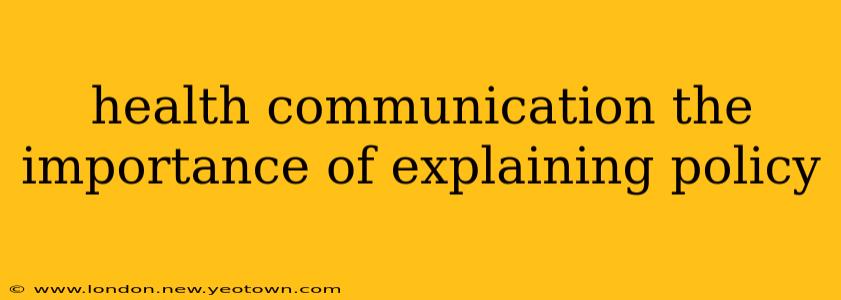Imagine this: you're diagnosed with a serious illness. Your doctor explains the treatment options, but then drops the bombshell – your insurance policy won't cover the best one. Frustration, confusion, and maybe even anger flood your mind. This isn't a hypothetical scenario; it's a reality for countless individuals navigating the complexities of healthcare. This is precisely where the crucial role of health communication in explaining policy comes into play. Effectively communicating healthcare policies is not just about disseminating information; it's about empowering individuals to make informed decisions, fostering trust in the system, and ultimately improving health outcomes.
Why is Explaining Health Policy so Important?
Clear and accessible explanations of health policy are vital for several reasons. Firstly, it promotes health literacy. Understanding complex policies, such as those related to insurance coverage, medication assistance programs, or preventative care initiatives, empowers individuals to actively participate in their healthcare. This knowledge empowers people to advocate for themselves and make choices that align with their needs and values.
Secondly, effective communication builds trust and confidence in the healthcare system. When people understand the "why" behind policy decisions, they are more likely to accept and comply with them. Transparency and open communication can significantly reduce misinformation and skepticism, fostering a more collaborative relationship between healthcare providers, policymakers, and patients.
Finally, explaining health policy can lead to improved health outcomes. By clarifying access to resources and services, policies can encourage preventative care, early detection of diseases, and adherence to treatment plans. This results in better health management and improved overall wellbeing.
What are the Challenges in Communicating Health Policy?
Despite its importance, communicating health policy effectively presents unique challenges. Healthcare policies are often complex, filled with jargon and technical language. Furthermore, they are frequently subject to change, making it difficult to keep the public informed. Moreover, information is often fragmented, spread across different government websites and agencies, making access challenging for many.
How Can We Overcome These Challenges?
Several strategies can improve health communication surrounding policy. First, simplifying language is paramount. Using plain language and avoiding technical terms makes complex information more accessible to a wider audience. Second, multiple communication channels should be utilized, catering to different audiences and preferences. This could involve websites, social media, infographics, videos, and community outreach programs. Third, interactive tools and resources can improve engagement and understanding. Quizzes, simulations, and easily accessible FAQs can make learning about health policies more engaging.
What are some best practices for explaining health policy?
Effective health communication regarding policy requires a multi-faceted approach. It's not enough just to provide information; we need to make sure it’s understood and acted upon. Here are some key strategies:
-
Target your audience: Understand your audience’s level of health literacy and tailor your communication accordingly. What works for a healthcare professional might be entirely ineffective for someone with limited health experience.
-
Use plain language: Avoid jargon and technical terms. Ensure your message is clear, concise, and easy to understand.
-
Use multiple channels: Don't rely on a single method to disseminate information. Utilize a combination of channels to reach a wider audience.
-
Provide context: Explain the rationale behind the policy and how it impacts individuals and communities.
-
Use visuals: Infographics, videos, and other visuals can make complex information more accessible and engaging.
-
Make it interactive: Engage your audience through interactive tools, quizzes, and online forums.
-
Promote feedback and dialogue: Encourage two-way communication and allow individuals to share their thoughts and experiences.
How Can I Find More Information About Health Policies?
Many reliable sources provide information on health policies. Government websites, such as those of the Department of Health and Human Services, offer detailed explanations and resources. Non-profit organizations and advocacy groups often provide consumer-friendly summaries and interpretations of policies.
In conclusion, effective health communication concerning policy is not just a matter of information dissemination; it's about empowering individuals, building trust, and ultimately, improving health outcomes. By employing clear, concise language, utilizing multiple communication channels, and prioritizing audience engagement, we can bridge the gap between complex policy and public understanding, leading to a healthier and more informed society.

